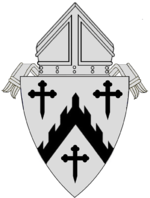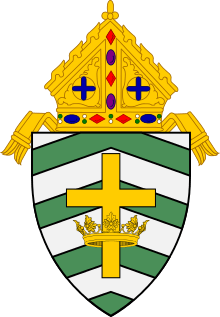Ralph Leo Hayes
Ralph Leo Hayes (September 21, 1884 – July 5, 1970) was a 20th-century bishop of the Catholic Church in the United States. He served as the fourth bishop of the Diocese of Helena in the state of Montana from 1933–1935, and as the fifth bishop of the Diocese of Davenport in the state of Iowa from 1944–1966. Between those two appointments, he served as the rector of the Pontifical North American College from 1935–1944.
Most Reverend Ralph L. Hayes, STD | |
|---|---|
| Bishop of Davenport, Iowa | |
 | |
| Church | Catholic Church |
| Appointed | November 16, 1944 |
| In office | January 11, 1945 – October 20, 1966 |
| Predecessor | Henry Patrick Rohlman |
| Successor | Gerald Francis O'Keefe |
| Orders | |
| Ordination | September 19, 1909 by Pietro Respighi |
| Consecration | September 21, 1933 by Hugh Charles Boyle |
| Personal details | |
| Born | September 21, 1884 Pittsburgh, Pennsylvania |
| Died | July 5, 1970 (aged 85) Davenport, Iowa |
| Previous post | Bishop of Helena, Montana Titular Bishop of Hieropolis Rector of the North American College |
| Motto | Opere et veritate (In action and truth) |
Biography
Early life and Ministry
Hayes was born in Pittsburgh, Pennsylvania to Patrick Nagle and Mary Jane (O’Donnell) Hayes. He received his high school and college education at Holy Ghost College (now Duquesne University). He played on the school football, basketball, and baseball teams while in college, and in the summer on a semi-pro baseball team. He studied for the priesthood at the Pontifical North American College and the University of the Congregation of Propagation of the Faith in Rome.[1]
He was ordained a priest there by Cardinal Pietro Respighi for the Diocese of Pittsburgh on September 19, 1909. He initially served in a parish before he was appointed to the diocesan mission band where he eventually served as its director. From 1917–1925 he was superintendent of schools for the Pittsburgh Diocese. He then spent seven years as pastor of St. Catherine of Siena Parish in Pittsburgh doing what he called ‘’real priest’s work.”[1]
Bishop of Helena
On June 23, 1933, Pope Pius XI appointed Hayes as the fourth bishop of the Diocese of Helena and he was consecrated bishop on September 21, 1933 by Bishop Hugh Boyle of Pittsburgh. The principal co-consecrators were Bishops James Griffin of Springfield in Illinois and Alphonse Smith of Nashville.[2] Both co-consecrators were classmates of his in Rome.[3] He served the diocese as its bishop for two years.[4]
North American College
On October 26, 1935, he was appointed Titular Bishop of Hieropolis and rector of the Pontifical North American College.[2] With the onset of World War II Pope Pius XII chose to temporarily close the national seminaries and Hayes returned to Pittsburgh. While in Pittsburgh, Hayes continued to look after the financial and other business matters relating to the college. He also assisted Bishop Boyle in his episcopal responsibilities.[5]
Bishop of Davenport
On November 16, 1944 Pope Pius XII appointed Bishop Hayes as fifth bishop of the Diocese of Davenport.[2] He was installed in Sacred Heart Cathedral on January 11, 1945. Pius XII also appointed him Assistant at the Pontifical Throne on April 30, 1958.[6]
During his 22 years in Davenport, there was an expansion to school facilities across the diocese.[7] Muscatine Central Catholic High School (now closed) in Muscatine (1953), Notre Dame High School in Burlington (1957), Regina High School in Iowa City (1958), Assumption High School in Davenport (1958), Aquinas High School (now Holy Trinity) in Fort Madison (1959), Walsh High School (now closed) in Ottumwa (1960), and Cardinal Stritch High School (now closed) in Keokuk (1965) were all established.[8] Many of these communities had been served by parish high schools, while Davenport's new high school was a merger of St. Ambrose and Immaculate Conception academies. New buildings were also added at St. Ambrose, Marycrest and Mt. St. Claire Colleges. The four bishops of Iowa built Mt. St. Bernard’s Seminary in Dubuque.
Enrollment in the Catholic Schools reached their highest enrollments during Bishop Hayes’ episcopate. Elementary school enrollment reached its highest mark in 1960 at 12,074. The high schools reached their highest mark in 1965 with 4,129 students.[9]
The church’s social teachings was a theme that ran throughout Bishop Hayes’ episcopacy. A four-day conference sponsored by the National Catholic Welfare Council was held in Davenport in 1949. It focused on the themes of industry, education and rural life. From 1954–1956 Bishop Hayes served as the president of the National Catholic Rural Life Conference.[10] Their national convention was held in Davenport, Iowa in 1956.
The Papal Volunteers of Latin America were established in the diocese in February 1961 in response to a plea from Pope John XXIII. Rev. Luis Colonnese, who would later become Director of the Latin American Bureau of the United States Catholic Conference, was put in charge. Fundraising was led by the Knights of Columbus, and Johnny Lujack, who was responsible for a special gift drive. For the most part, missionaries from the diocese went to Cuernavaca, Mexico or to Ponce, Puerto Rico.[11] The Pacem in Terris Peace and Freedom Award was created by the Davenport Catholic Interracial Council in 1964 in commemoration of the 1963 encyclical Pacem in terris by Pope John.
Bishop Hayes attended all four sessions of the Second Vatican Council. He was the oldest bishop from the United States at the council.[12] The Catholic Messenger published the decrees of the council in their entirety in the paper. Liturgical renewal was already underway in the diocese under the direction of the Rev. Cletus Madsen. In the 1950s he had been working on reforming liturgical music in the diocese by advocating the replacement of the more sentimental devotional music with liturgical music and participation by the laity. He also advocated teaching children Gregorian Chant so as to lead the congregation in singing.[13]
Later life and Death
On his 82nd birthday, September 21, 1966, Bishop Hayes submitted his resignation to the Holy See in compliance with the Vatican II decree Christus Dominus. His resignation was the first such resignation accepted by Pope Paul VI.[12] On October 20, 1966, he was named Titular Bishop of Naraggara and Bishop Emeritus of Davenport. He retired to the Kahl Home. He died there in 1970 at the age of 85. Following his funeral in Sacred Heart Cathedral, Bishop Hayes was laid to rest in the Bishop's Circle of Mt. Calvary Cemetery.[14]
Legacy
Hayes Hall, the former seminary building and now an academic building at St. Ambrose University in Davenport, and Bishop Hayes School in Muscatine, Iowa are named in his honor.
References
- Schmidt, Madeleine M. (1981). Seasons of Growth: History of the Diocese of Davenport. Davenport, Iowa: Diocese of Davenport. p. 221.
- "Bishop Ralph Leo Hayes". catholic-hierarchy.org. Retrieved 2009-07-31.
- Schmidt 1981, p. 221.
- "A brief history of the Diocese of Helena". www.diocesehelena.org. Archived from the original on 2008-07-05. Retrieved 2020-07-13.
- Schmidt 1981, p. 220.
- The Official Catholic Directory. New Providence, New Jersey: P.J. Kenedy & Sons. 2009. p. 362.
- Dawson, W.F (1967). New Catholic Encyclopedia. vol. 4. New York: McGraw-Hill. p. 656.
- Schmidt 1981, p. 258-59.
- Schmidt 1981, p. 316.
- Schmidt 1981, p. 224.
- Schmidt 1981, p. 244.
- Schmidt 1981, p. 241.
- Schmidt 1981, p. 228-29.
- Ralph Leo Hayes at Find a Grave
| Catholic Church titles | ||
|---|---|---|
| Preceded by George Joseph Finnigan |
Bishop of Helena 1933–1935 |
Succeeded by Joseph Michael Gilmore |
| Academic offices | ||
| Preceded by Eugene S. Burke |
Rector of the Pontifical North American College 1935–1944 |
Succeeded by J. Gerald Kealy |
| Catholic Church titles | ||
| Preceded by Henry Rohlman |
Bishop of Davenport 1944–1966 |
Succeeded by Gerald Francis O'Keefe |


